La Mille Miglia, Part 1 UK to Brescia
A longtime contributor to VeloceToday, Graham Earl entered this year’s Mille Miglia with one of our favorite cars, an Alfa Giulietta Sprint. Earl is a veteran of three Mille Miglias, and in no respect a novice. This three part article is an absolute must-read and like the Alfa and the Mille Miglia, itself a classic. Remember Henry Manney’s account for Road & Track? This one is better! Ever wanted to run the Mille Miglia? Read it! Owned an Alfa? Delight in it! Earl writes the truth while composing one of the most maddeningly humorous and interesting series of articles to appear in VeloceToday. Ever. We’ll also make it available as a pdf so you can read it at your leisure. Ed.
Before its demise in 1957, the Mille Miglia had been one of the most important rounds of the world championship for sports cars, and became the happy hunting ground for Alfa Romeo and Ferrari, with 11 and eight wins respectively, out of the 24 events run. Other manufacturers also took it very seriously, with works entries from Porsche, Maserati, Lancia (winner in 1954), Jaguar, Bentley and BMW (who won the event in 1940) to name just a few. The first race, in 1927 was won, appropriately enough, by local brand O.M. (Officine Meccaniche) and the fastest race was held in 1955, when Stirling Moss took the Mercedes round the 1,000 mile course in a fraction over ten hours to average nearly 100 mph and give the German manufacturer their second win. Think about that speed. This was on public roads, in 1955, flat out without a break, through towns, over mountains and down valleys with little or nothing in the way of safety barriers. Incredible!
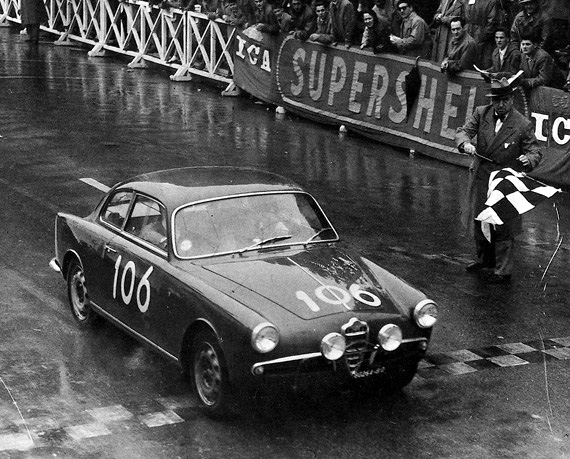
Mille Miglia, 1956. The Alfa Sprint Veloce crossed the finish line 11th overall and first in class, driven by Sgorbati and Zanelli.
Not surprisingly, the Mille Miglia is legendary.
Today the event lives again, not as a flat-out race, but a timed regularity trial. Competitors are expected to meet the timing points at their scheduled times, and penalties are handed out for inaccurate timing. The car with the fewest penalties at the end of the event is the winner. In 1977 the 20th anniversary of the last Mille Miglia was celebrated with a revival, in which cars from the period of the original event could retrace the route under controlled conditions, and at legal speeds (?) on roads still open to other traffic. The event was such a success that it was re-run again in 1982, when it was decreed that it would be run from now on biennially. A few years later the recurrence was increased and it became an annual event.
So, every May a 400-odd strong gathering of some of the world’s finest historic sports and racing cars assembles in Brescia in anticipation of a 1,000 mile jaunt through the Italian countryside, visiting some of the most beautiful towns and cities along the way, while experiencing every weather condition, from blazing hot sun to freezing snow, fog and rain. The Mille Miglia has it all.
What does one have to do to enter?
This might sound pretty attractive as an event to take part in, so what does one have to do to enter? To secure a place, your car has to have taken part in the original event, prior to 1958, or failing that, it has to be identical to one that did. Simply owning an eligible car does not automatically gain you entry. Assuming you can meet the above criteria, your car has to be confirmed as totally authentic and original, and this is done by obtaining a FIVA passport, which is achieved by having the car inspected by a local FIVA representative, and paying the appropriate fee. The organizing committee opens the application process during the latter part of the previous year, and would-be participants are invited to enter via the event web site. Car and crew details need to be submitted, along with photographs of the car, and proof of its eligibility.
Oh, and the small matter of the entry fee – €8,500 (about $14,400). Cars which are proven to have original Mille Miglia history are pretty well assured of being accepted, but for the rest of the applicants the better the car’s history, the more complete and original it is, the greater your chance of being accepted. If your car isn’t to original specification, and isn’t of a type which raced on the event between 1927 – 1957, forget it. You will not be accepted. The organizers aim to recreate the original event as accurately as possible, with as broad a representation of the original participants as possible, so don’t assume that just because you have a particularly nice Ferrari or Maserati you will be accepted. The intention is not to have three or four hundred similar cars, but a proper cross section, illustrating the diversity of the entrants in period.
Make no mistake, it is a very tough test of both machine and crew…
Having established that your car is eligible, and having sent in your application and paid your entry fee, you wait to be told whether or not you have been accepted. Notification is made during February, and the unsuccessful applicants (usually well over a thousand) have their entry fees refunded (minus a handling charge!). For the successful applicants a mixture of emotions begins to unfold; firstly excitement, then descending either rapidly or gradually, depending on your state of preparedness, into anguish and desperation, as the discovery of the need for last minute preparations becomes clear. For make no mistake, this event is a very tough test of both machine and crew, and any shortcomings in the car’s preparation will be found out.
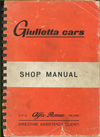 This year I entered a very early first series Alfa Romeo Giulietta Sprint from 1955, a car which was already a veteran of previous Mille Miglias. Confident that the car was up to the task, having had many thousands of pounds spent on mechanical maintenance over the last couple of years, it was not until I took the car to be photographed that I became aware of any problems. Occasionally the car would refuse to start if laid up unused for a lengthy period, but this was usually remedied by a gentle tapping on the carburetor to release the needle valve, which had a tendency to stick – a problem caused by wear. Not having used the car for some time I was not surprised to have to go through this ritual when I removed it from the garage, but I was totally unprepared for the breakdown which ensued just half a mile along the road.
This year I entered a very early first series Alfa Romeo Giulietta Sprint from 1955, a car which was already a veteran of previous Mille Miglias. Confident that the car was up to the task, having had many thousands of pounds spent on mechanical maintenance over the last couple of years, it was not until I took the car to be photographed that I became aware of any problems. Occasionally the car would refuse to start if laid up unused for a lengthy period, but this was usually remedied by a gentle tapping on the carburetor to release the needle valve, which had a tendency to stick – a problem caused by wear. Not having used the car for some time I was not surprised to have to go through this ritual when I removed it from the garage, but I was totally unprepared for the breakdown which ensued just half a mile along the road.
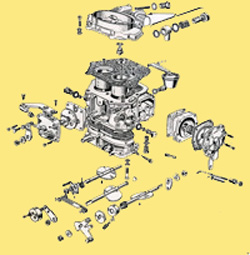 Fortunately, the car came to a halt outside a service garage, where we discovered that the filter in the fuel pump was clogged with debris from the fuel tank, which had also found its way through the other filters and into the carburetor. I left the car with them to sort out, and later that day the garage rang to tell me they had removed the fuel lines, blown them through and cleaned the tank. So I collected the car and put it away again. Next morning I tried again, but didn’t get as far as the end of the driveway before it quit again.
Fortunately, the car came to a halt outside a service garage, where we discovered that the filter in the fuel pump was clogged with debris from the fuel tank, which had also found its way through the other filters and into the carburetor. I left the car with them to sort out, and later that day the garage rang to tell me they had removed the fuel lines, blown them through and cleaned the tank. So I collected the car and put it away again. Next morning I tried again, but didn’t get as far as the end of the driveway before it quit again.
Now the anxiety was setting in. This is a car that had been well maintained, and had not wanted for money and care to be lavished on it, and yet it still wasn’t right.
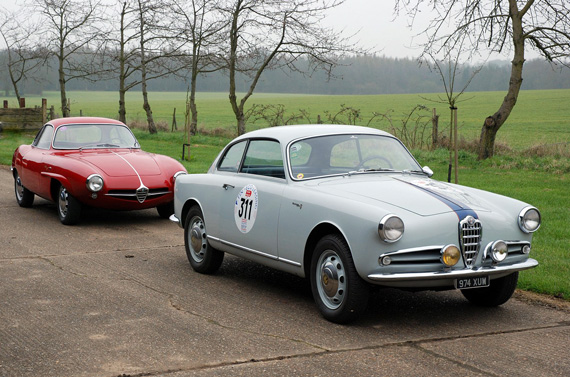
Getting ready to road test the Alfa. Behind the Sprint is a low nose SS, the result of the author’s 20 year search.
When I collected the Alfa, I now found a nasty flat spot in the power curve, which was particularly noticeable on right hand corners. A decision was made to drive it as much as possible to try to force any other issues to the surface, but the wettest winter on record, with ceaseless daily rainfall and heavy flooding, prevented me from using the car as much as I would have liked. Eventually the rain stopped long enough for me to take the car out on the odd occasion, and I put on quite a few miles without incident. Further adjustment of the carburetor improved the flat spot, without altogether eradicating it, but it was manageable now. So, everything seemed to be in order as I received the happy news that the car had been accepted for the event.
After sixty years it was entitled to display some signs of fatigue…
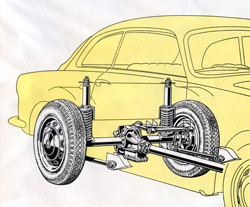 But then, the knocking noise from the rear grew worse, and warranted much further investigation. Which is when I discovered, to my horror, that the unit-frame chassis was cracked around both rear shock absorber top mounts, allowing the shocks to move around and rattle against the inside of the coil springs. This was an unforeseen issue, which needed urgent attention, so the car was delivered to my body shop for reparatory welding. This is clearly a design weakness, and not something caused by neglect, for there is zero corrosion anywhere in this amazingly well-preserved car, but after sixty years I suppose it was entitled to display some signs of fatigue.
But then, the knocking noise from the rear grew worse, and warranted much further investigation. Which is when I discovered, to my horror, that the unit-frame chassis was cracked around both rear shock absorber top mounts, allowing the shocks to move around and rattle against the inside of the coil springs. This was an unforeseen issue, which needed urgent attention, so the car was delivered to my body shop for reparatory welding. This is clearly a design weakness, and not something caused by neglect, for there is zero corrosion anywhere in this amazingly well-preserved car, but after sixty years I suppose it was entitled to display some signs of fatigue.
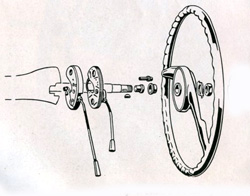 Once again I dared to believe that all problems had been resolved and the car was fit for its Italian adventure. Apart, that is, from an aberrant signal indicator which started to turn on unbidden every time I turned the steering wheel. Fortunately a liberal squirt of spray grease adequately resolved this small issue and I was breathing easier again.
Once again I dared to believe that all problems had been resolved and the car was fit for its Italian adventure. Apart, that is, from an aberrant signal indicator which started to turn on unbidden every time I turned the steering wheel. Fortunately a liberal squirt of spray grease adequately resolved this small issue and I was breathing easier again.
That was until it developed a new problem, whereby it refused to run unless the choke was pulled out. The problem was eventually diagnosed to be caused by fine silt which had got through the fuel filters into the carburetor and blocked some of the jets. This was hard to identify because fuel was getting through, and the jets all looked clear. The carb was stripped down maybe half a dozen times and reassembled, before the problem was found. The silt had lodged in one of the jets in such a way as to allow fuel through, but to have disturbed the pattern of the flow. Instead of a fine mist of fuel I was getting a torrent, in much the same way as placing your finger over the end of a garden hose. This was enough to stop the car from running properly, and a difficult problem to identify.
Having got the car to run well again things were looking up, but of course, that’s only ever a temporary state of affairs. It couldn’t last, and it didn’t, because on driving with a passenger on board a new creaking noise was apparent, which hadn’t been present before. Investigation showed this to be a cracked frame on the passenger seat, so this had to be removed, welded and painted. As it turned out, not a big deal, but just yet another problem to be overcome before tackling this challenge.
Have you ever changed an Alfa dynamo in the rain?
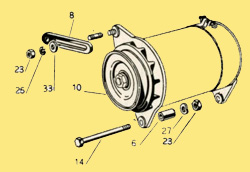 Then, returning home one evening in the car the lights went out, the indicators stopped working and eventually the engine died. The battery was dead, so in a fit of stupidity I decided to remove the dynamo and check it over, because I suspected that it wasn’t charging properly. What should have been a really simple job became inexplicably complicated, due to inaccessibility of the attachment bolts. My stupidity became ever more apparent when, having undertaken this simple job outside in fine weather, the heavens opened and dumped a month’s worth of rain in a couple of hours. That was unpleasant!
Then, returning home one evening in the car the lights went out, the indicators stopped working and eventually the engine died. The battery was dead, so in a fit of stupidity I decided to remove the dynamo and check it over, because I suspected that it wasn’t charging properly. What should have been a really simple job became inexplicably complicated, due to inaccessibility of the attachment bolts. My stupidity became ever more apparent when, having undertaken this simple job outside in fine weather, the heavens opened and dumped a month’s worth of rain in a couple of hours. That was unpleasant!
That was also when I discovered that the windscreen seal, which I had previously asked to be replaced because it leaked, still leaked. I had been persuaded that the leak was coming from the wiper arm seals, and these were duly replaced, but a footwell full of water demonstrated that the cause of the leak was still present. As it transpired, the dynamo was fine, but the battery was finished, so a replacement was purchased and that little problem was banished. However, the flat battery-induced failing lights caused me to have a look at those, and it was only then that I discovered the headlamp reflectors were rusty, and not capable of projecting a good spread of light. There was no time to do anything about that, so I reassembled the lights, refitted them to the car and told myself I’d manage. Until this time I had never really had cause to use the car in the dark, and hadn’t appreciated how feeble the lights are.
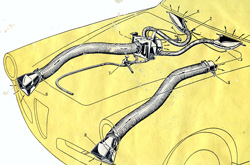
With two days to go before the transporter came to take the car away a new windscreen seal was ordered and I took the car back to my specialist repairer. The new seal was fitted, and several other minor jobs were carried out, such as a non-operating horn (blown fuse) and the fitment of a heater tap, which a previous owner must have removed at some stage. That meant the heater was permanently on – not useful in Italy in May, where ambient temperatures would be above 30 degrees C. While we were about it the windscreen washers, which had decided to stop working, were also fixed.
With time running out, once again I felt the car was ready to go to Italy.
And it truly was this time, until…
Next week, Brescia to Rome
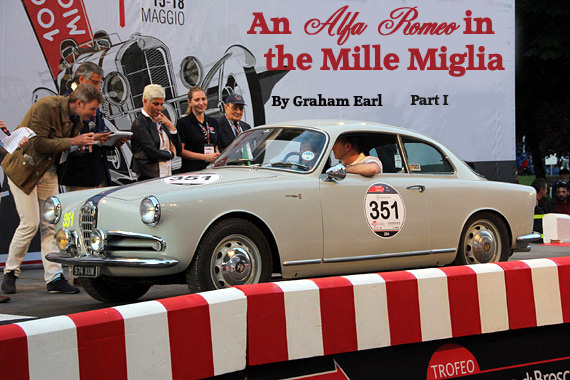
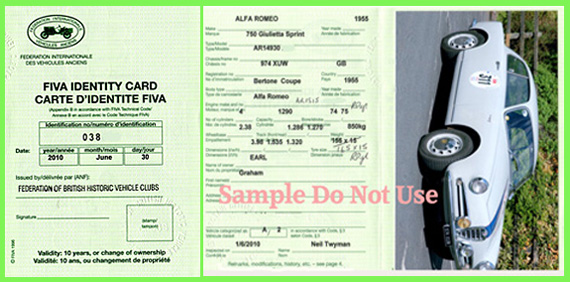
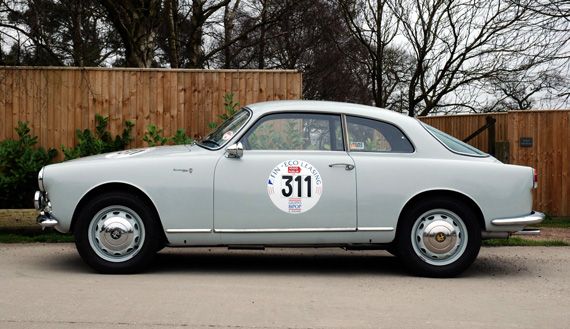
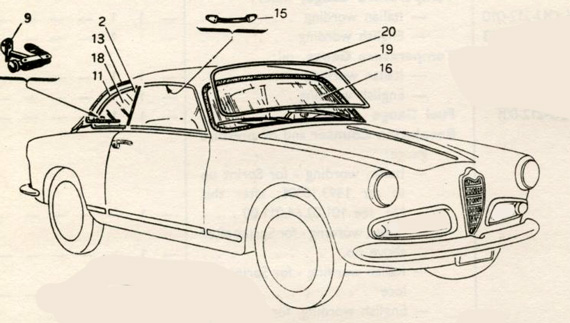
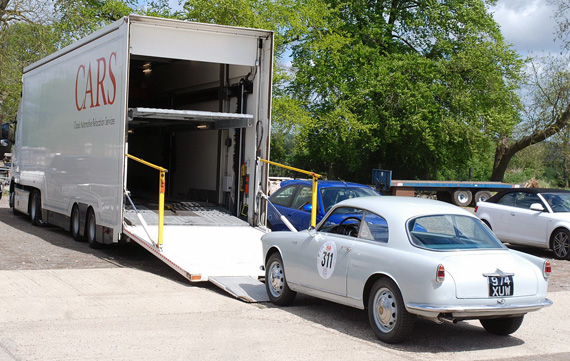
The ca must have an interesting history or may have participated in the original MM, as there must be a number of Giulietta applicants. In my experience, a Giulietta, even a very original one, without special history would hardly qualify, but in any case the screening process by the organisers is rather opaque, so who knows?.. A detail: the fee is rather on the USD 10,000 side, already a hefty figure… The story of the preparation to the MM is so true! We are all going through similar stories! We will probably read it in the next episode of the story, but the main challenge during the MM is there there is absolutely no time to fix even small problems during the MM: arriving every evening between 1 and 3 AM (yes, AM) and departure at 7 to 8 AM, that is wake up 5 to 6 AM. The MM caravan passes at any given point in about one and a half hour, so with number 311 (late number), if you have to stop for more than 1/2 hour, you are out as the controls close immediately after the last car goes through, and as the other participants really drive to the limit, little chances to catch-up, except if you are Nuvolari (no speed limits!!). But what an experience! The most rewarding part is the enthusiasm of the Italian crowd and the pleasure to give them a show they appreciate.
Ohh how I know this story – and the car hasn’t left home yet.
In 2013 I entered my 250 Europa GT – but factor in the fact the car had to be shipped from New Zealand. Time is never on your side. I look forward to the balance of the anguish. I’m sure there will be parallels a plenty. Ending with a happy story.
Wow. And I thought only old Jaguars spent more time in the garage than on the road!
Good to know I am in good company now with an Italian marque.
The story is familiar to any sport car of the 50’s, even when fairly new. My first car, a Singer 4AD, had an intermittent SU fuel pump, The second car, an HRG, fortunately had an American Bendix as a back-up in the reserve tank. My Alfa 1900C had very interesting insulation flaking off the chassis wiring, and rear axle bushing “thump”. et cetera. These cars were made to provide joy to the driver, which was not a feature of American cars. Although the fun was sometimes limited, it was still fun as long as it lasted. The same Alfa had a tendency on the highway to run well for a while, and then feel rough, which could only be cured by pressing the accelerator pedal harder. Before I knew it, the speedometer was at 125 MPH, which would frighten me, as keeping my license was a difficult task.
In addition to the 14 large for admission to the game after pedigree FIVA approval, the author’s wallet must have been a mighty heavy one to afford all those little fixes the car required even before being trucked off for it’s trip to Italy…with quite a few more dollars still to be involved hauling it over and back home after the event. I’ll be interested in reading about the actual participation and results to learn if the author’s casual attitude toward such piddling expenditures continues right up to the grand finale?
I am the proud owner of 3 1960 cars, a Giulietta Sprint, Fiat 1100 sedan and a Lancia Flaminia Touring, in the last 10 years I have never had an issue except for a flat battery on the giulietta, my fault for leaving the lights on !!
All are used regularly, guess my mechanic knows what he’s doing !!
I also have a 1963 corvette convertible which is driven almost every day from April to November!!!